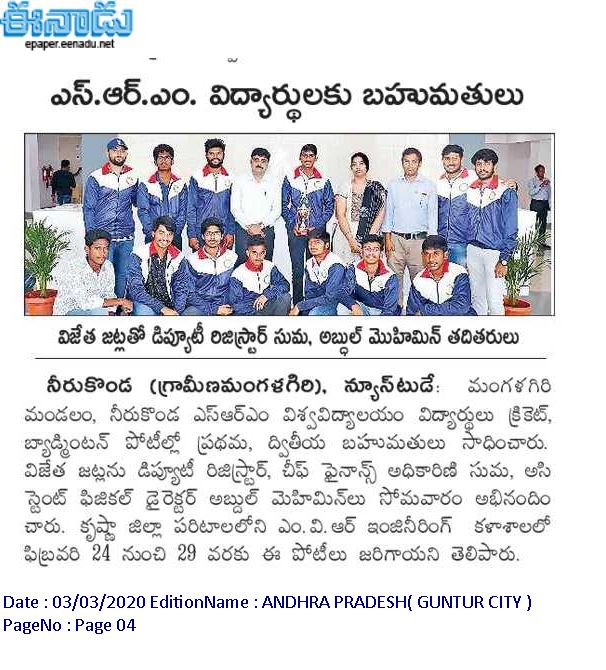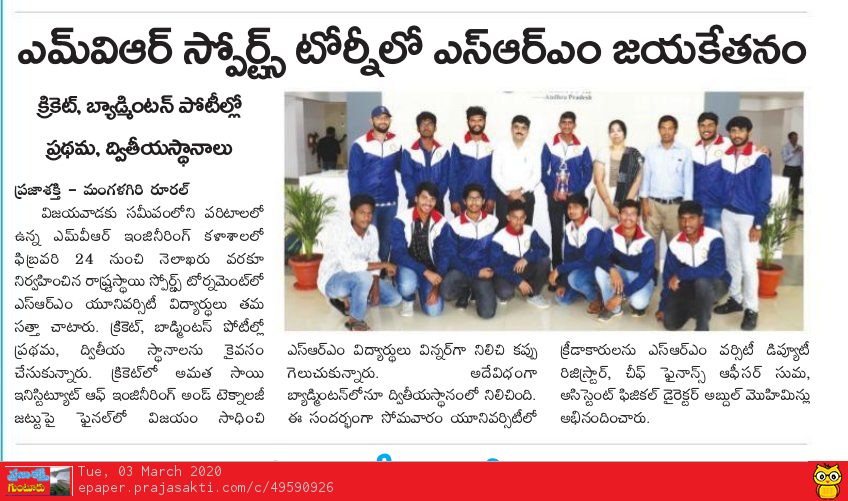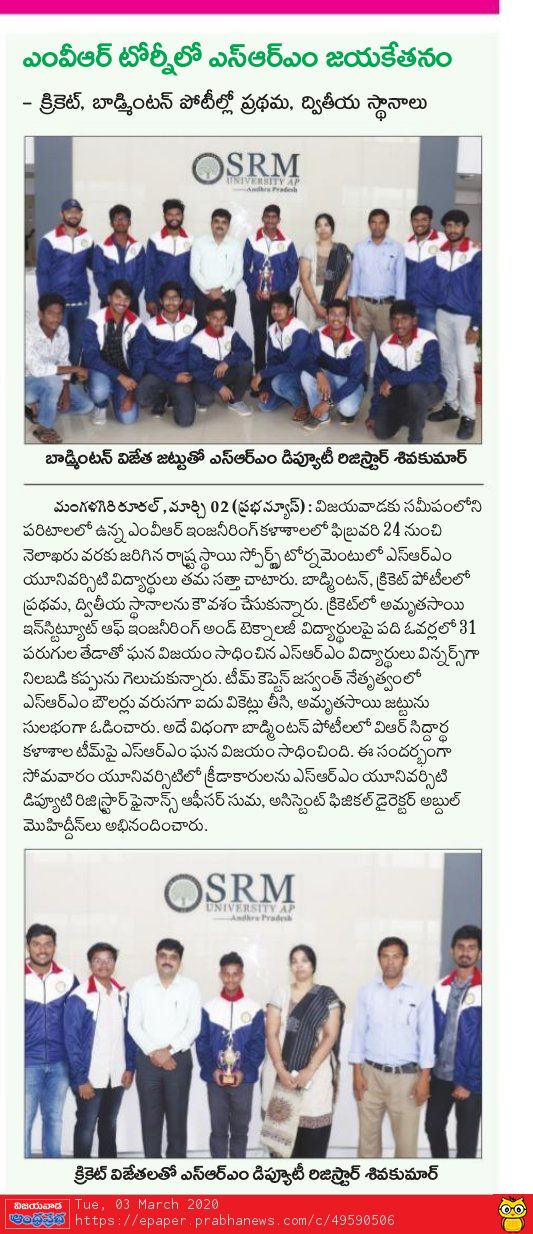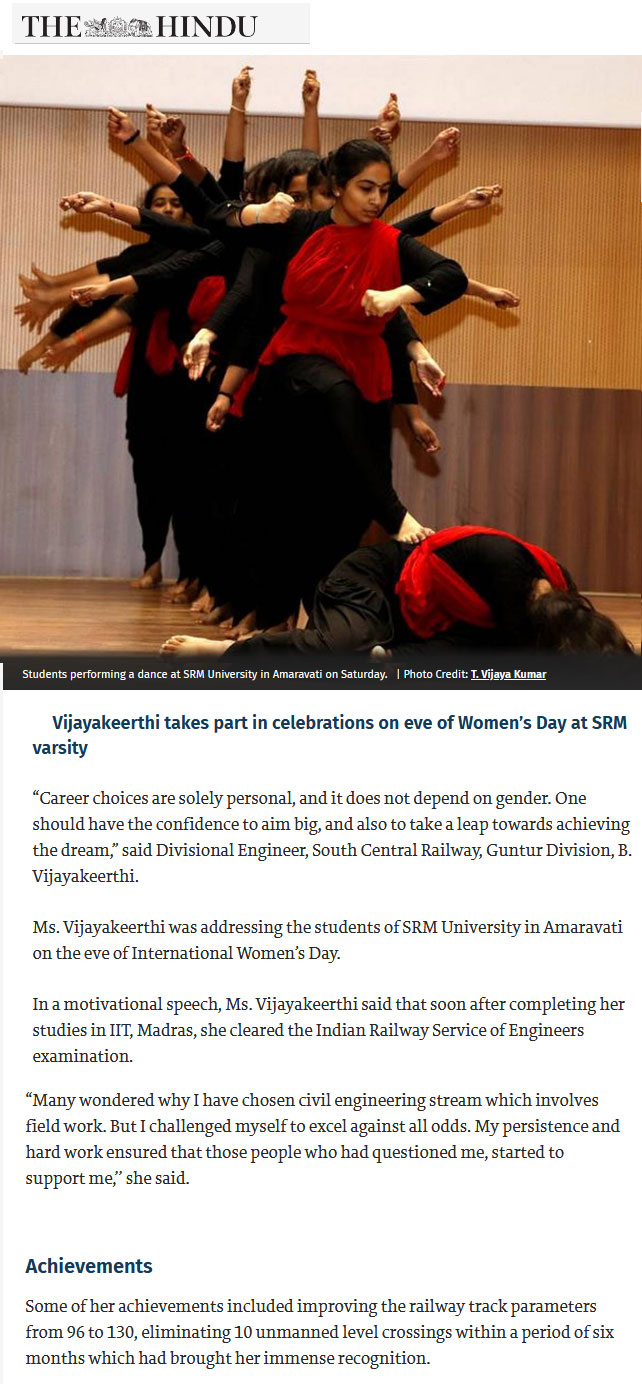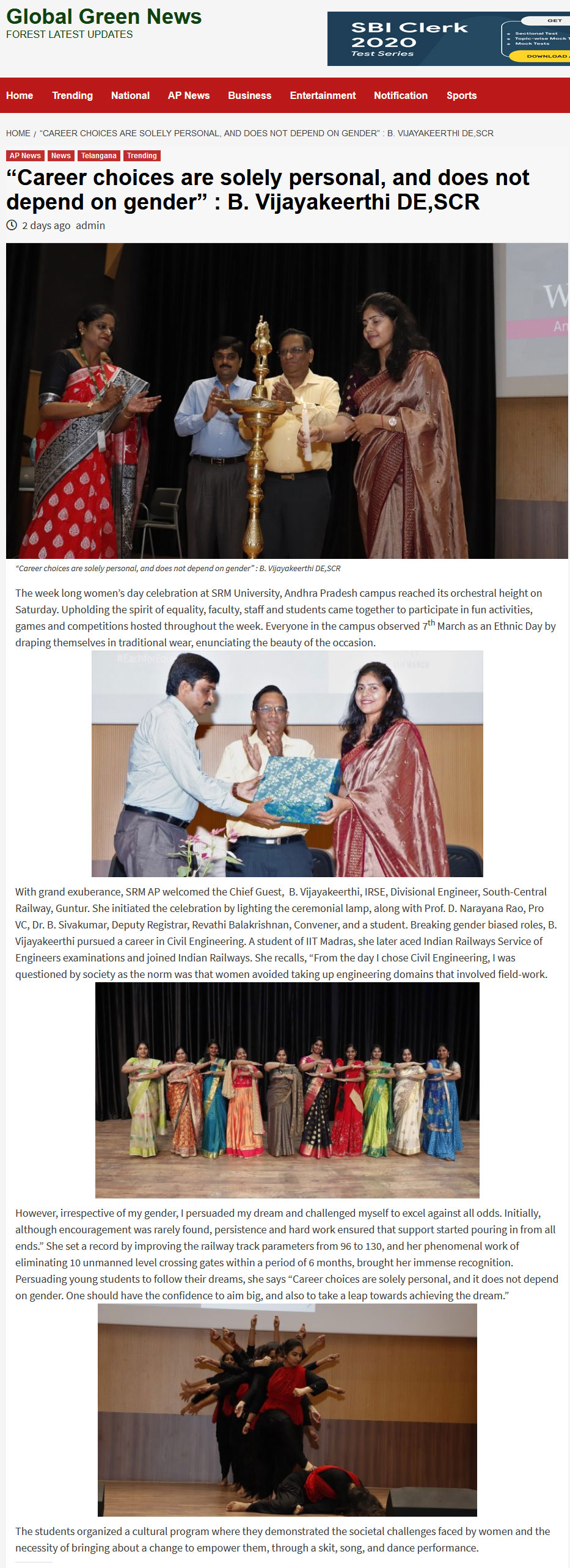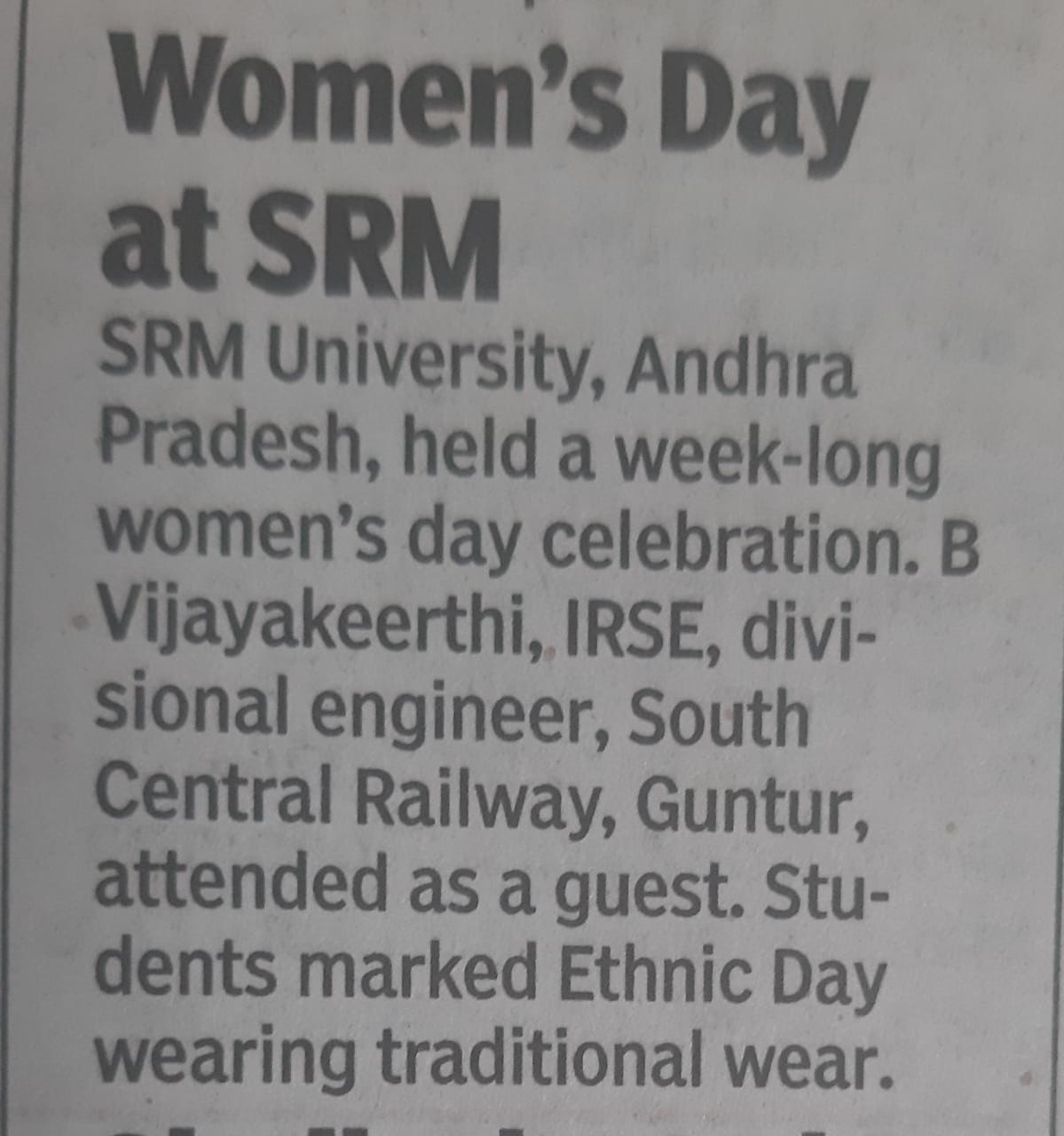SRM AP Students’ Sports Team Win at MVR Engineering College
- Published in Newsroom
SRM-AP Next Tech Lab Bags Laurels on Blockchain Technology
Prototypes were awarded in ETHDenver International Hackathon
Innovations of SRM University-AP’s Students were acknowledged and rewarded in ETHDenver, an International Conference organised by Ethereum Foundation. Ethereum Foundation is the largest platform for blockchain technology development. In this conference, they arranged for an US Blockchain Technology Hackathon, the biggest challenge on blockchain technology developments and applications. Approximately 2000 students across the world registered for the conference. Students of SRM-AP presented their innovative ideas with prototypes and secured bounty of total $3000 for their projects called URBANBOWL and SECURENOTE. They were also awarded the Community Prize for being on the Top 5. As a part of Global Scholars Programme supported by Ethereum Foundation, the students represented SRM University-AP in the conference.
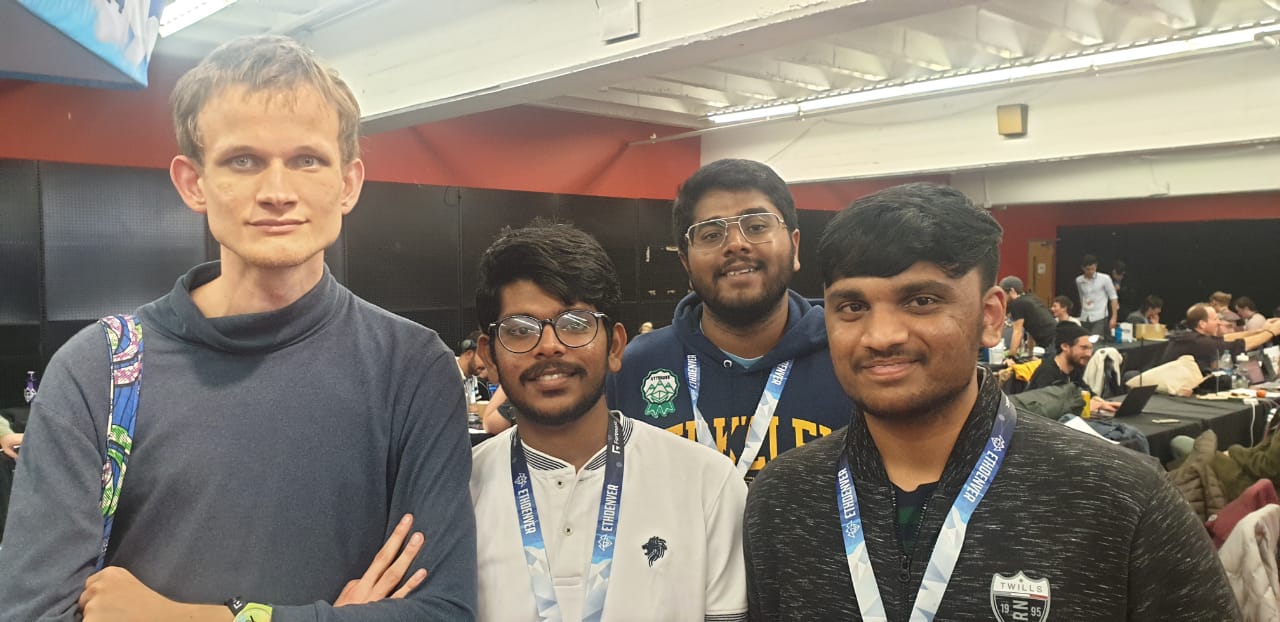
Urbanbowl partcipants in ETHDenver with Vitalik Buterin, co-founder of Ethereum
URBANBOWL was developed by Koushik Bhargav, Pushyamitra, Srinivas Teja and Rohit, four students of 3rd year, Computer Science and Engineering Department. This project was about making cities self-sustainable by urban farming on rented places. Considering the American societies, where people have unused places like the backyards, the students developed prototype of Urbanbowl, a decentralised urban farming platform where people can lease out empty spaces like backyards or basements. This platform was developed using blockchain technology. Their project also satisfied five UN Sustainable Development Goals (SDG)- End Hunger, Sustainable Cities and Communities, Reduction in Forest Loss and Land Degradation, Climate Action and Sustainable Production Pattern. The students received a bounty of $500 from SKALE and $500 from DAPPHERO for their project.

Securednote participants praised in ETHDenver
SECURENOTE, the second project from SRM-AP, was also highly praised in the conference. Yoganand and Nikhil, 3rd year students of Electronics and Communication Engineering along with Chaitanya and Abhin, 3rd year students of Computer Science and Engineering were the brains behind the project. They have developed a platform where people’s complaints will not go unnoticed. The present scenario in Indian police station shows that people register their complaints manually, and most of the times, those complaints get lost or no action is taken. Using blockchain technology, students of SRM-AP have developed such a platform where such complaints will be registered and digitised in such a way that cannot be modified later without bringing it into notice of all the concerned authorities. This will make the process more secure as none will be able to alter or modify the complaints without notifying the concerned people. They also have received a bounty of $2000 from DAOSTACK for their project.
Click here to view press coverage
- Published in News
Next Tech Lab Bags Laurels on Blockchain Technology
Blockchain tech based urban farming platform developed by srm
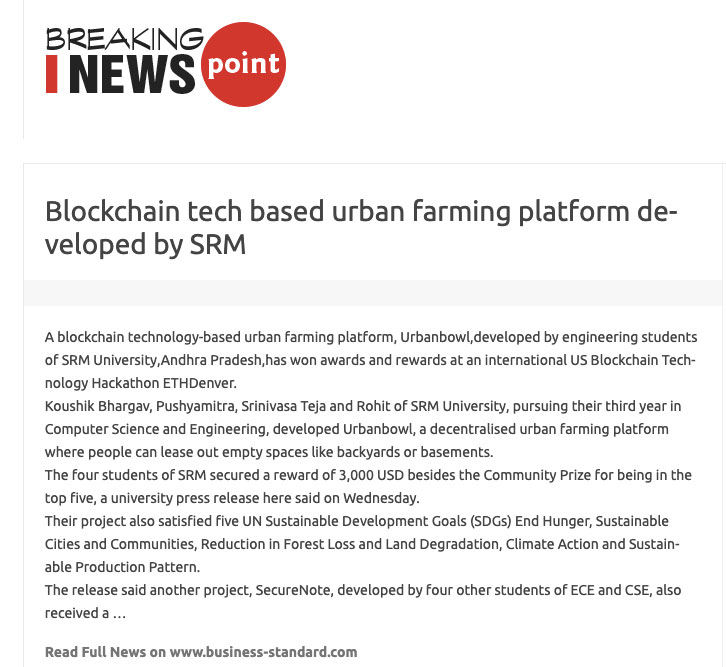
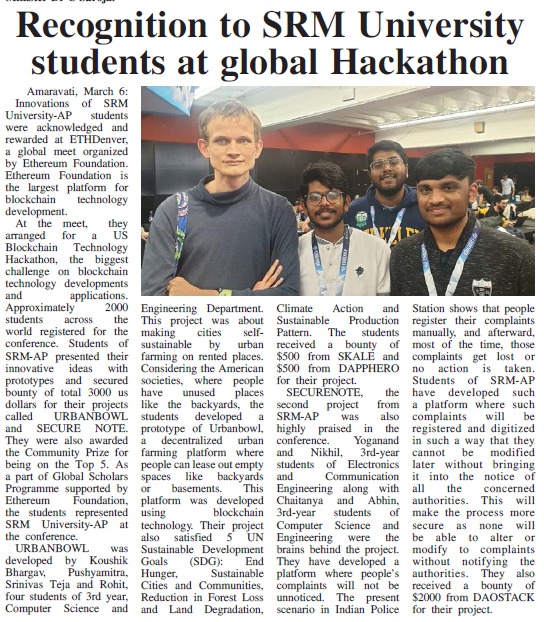
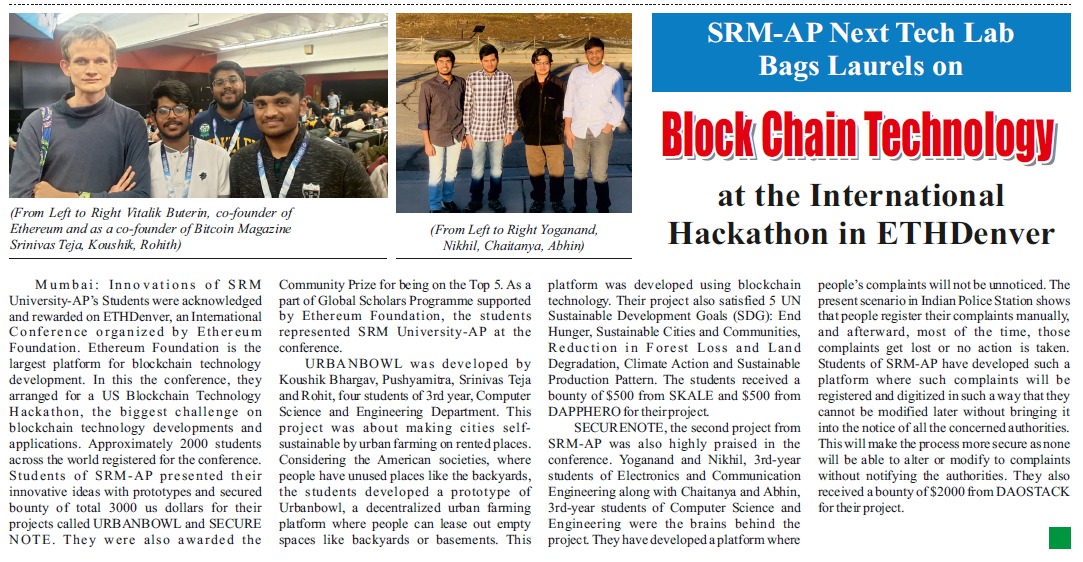

SRM AP: Happy news, students win Ntnl competition

Young minds from SRM University, AP excelled at national level Hackathon amidst the Quarantine
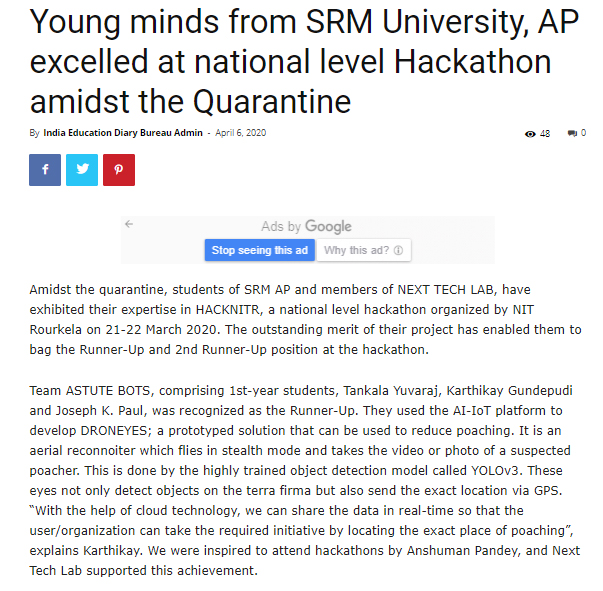
Afternoon – English Dairy
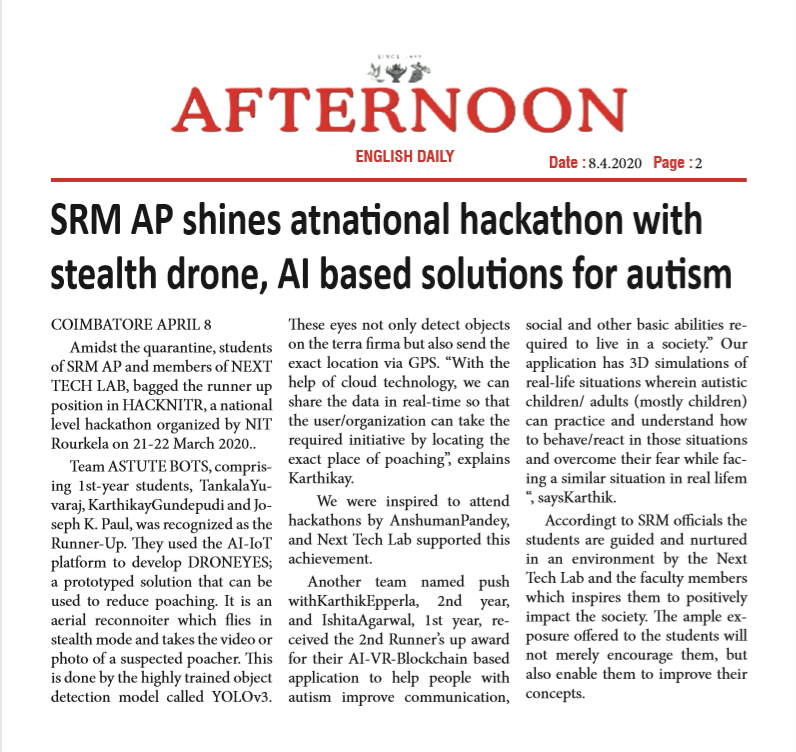
SRM AP students excel at nationa level online hackathon
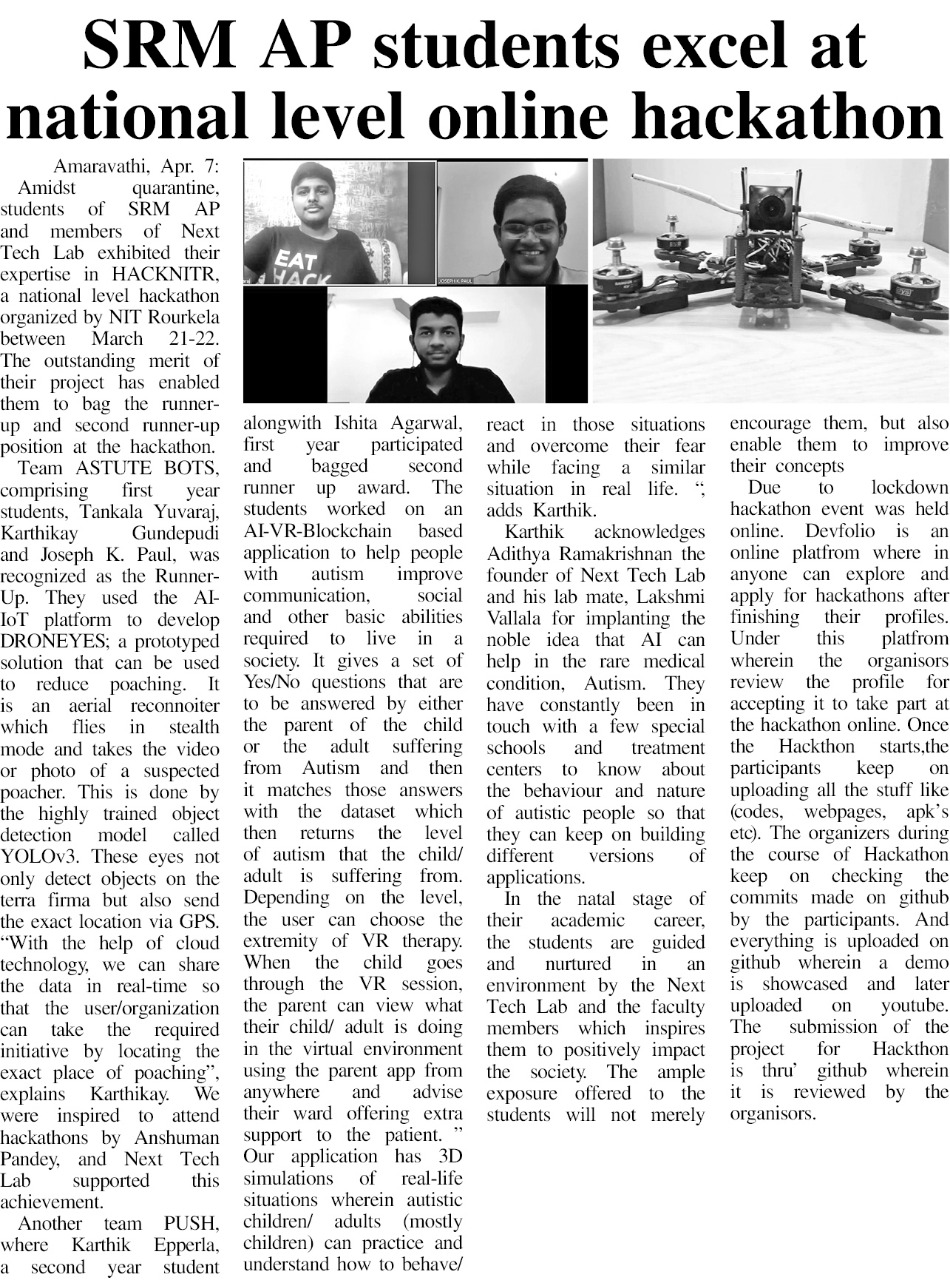
Got-space? Will grow!
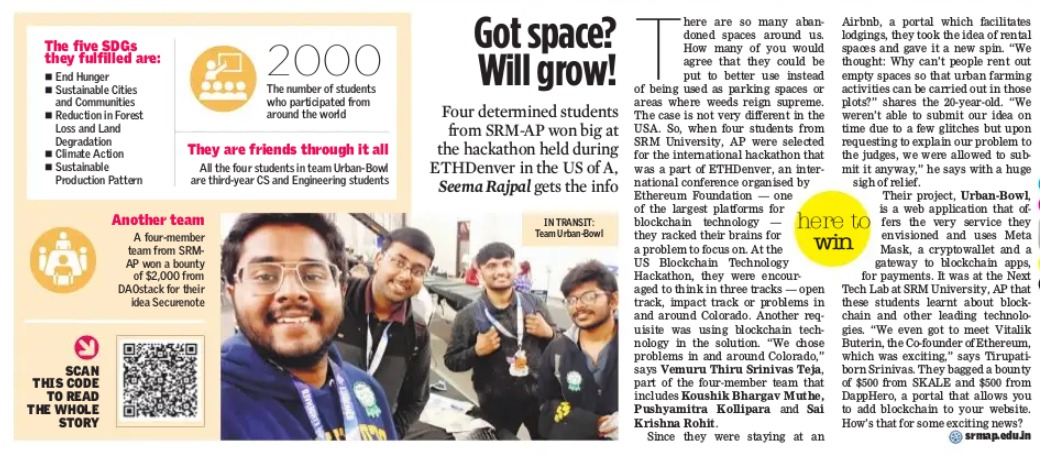
The Asian Age
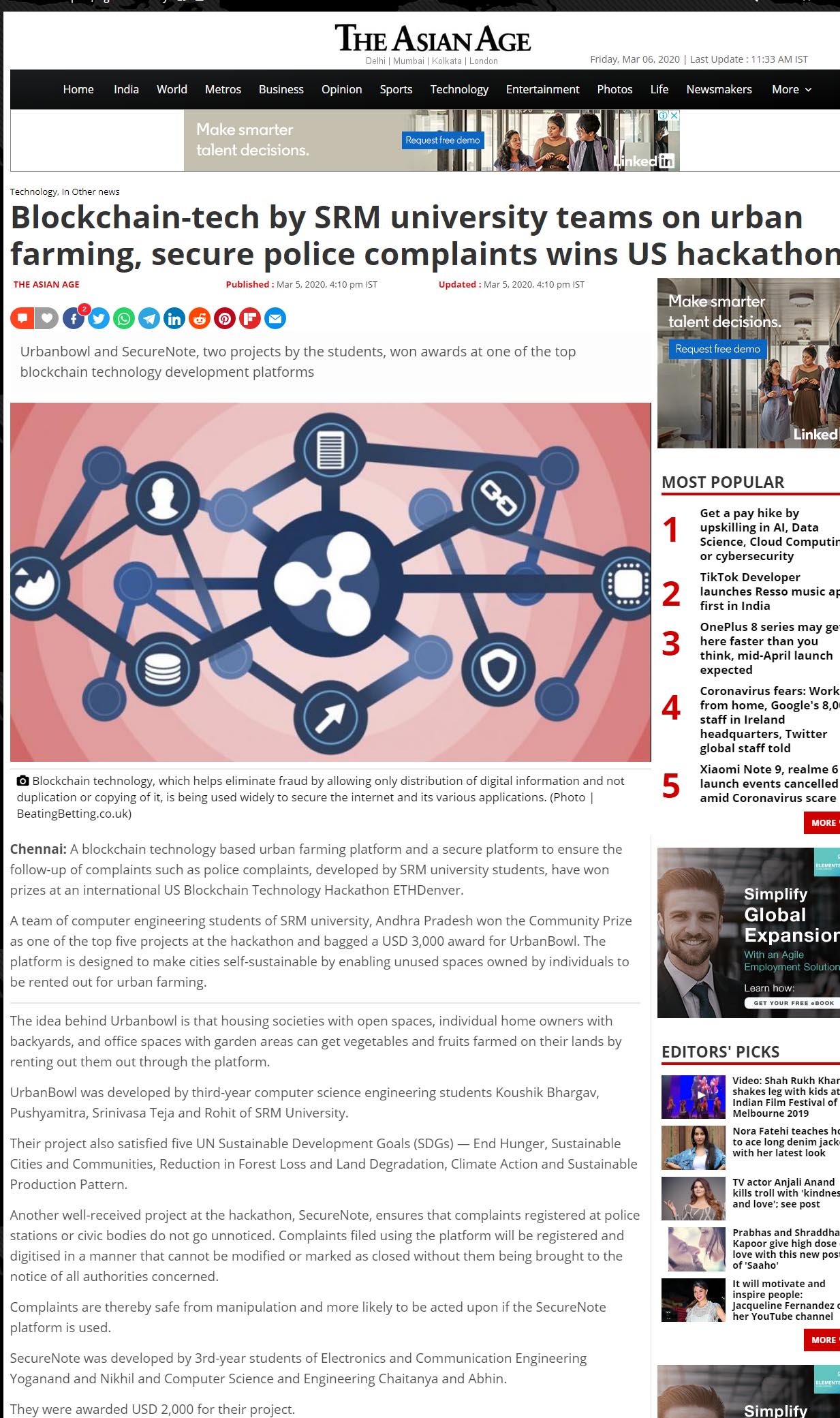
Yahoo Finance
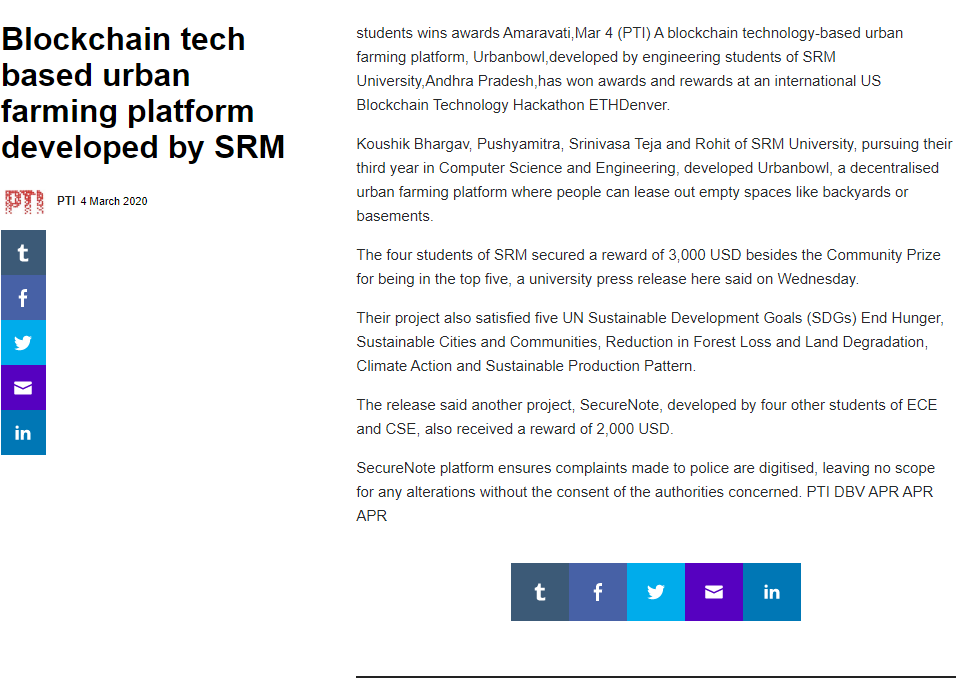
India Education Diary
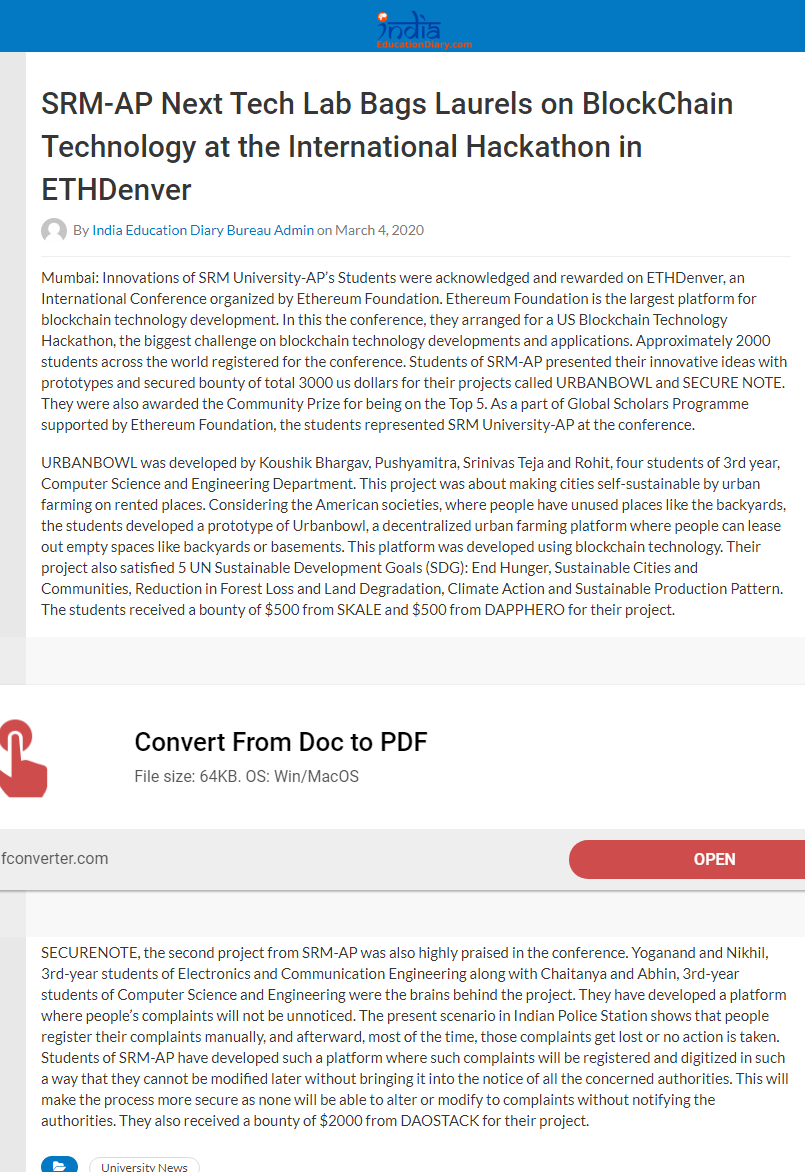
Devdiscourse
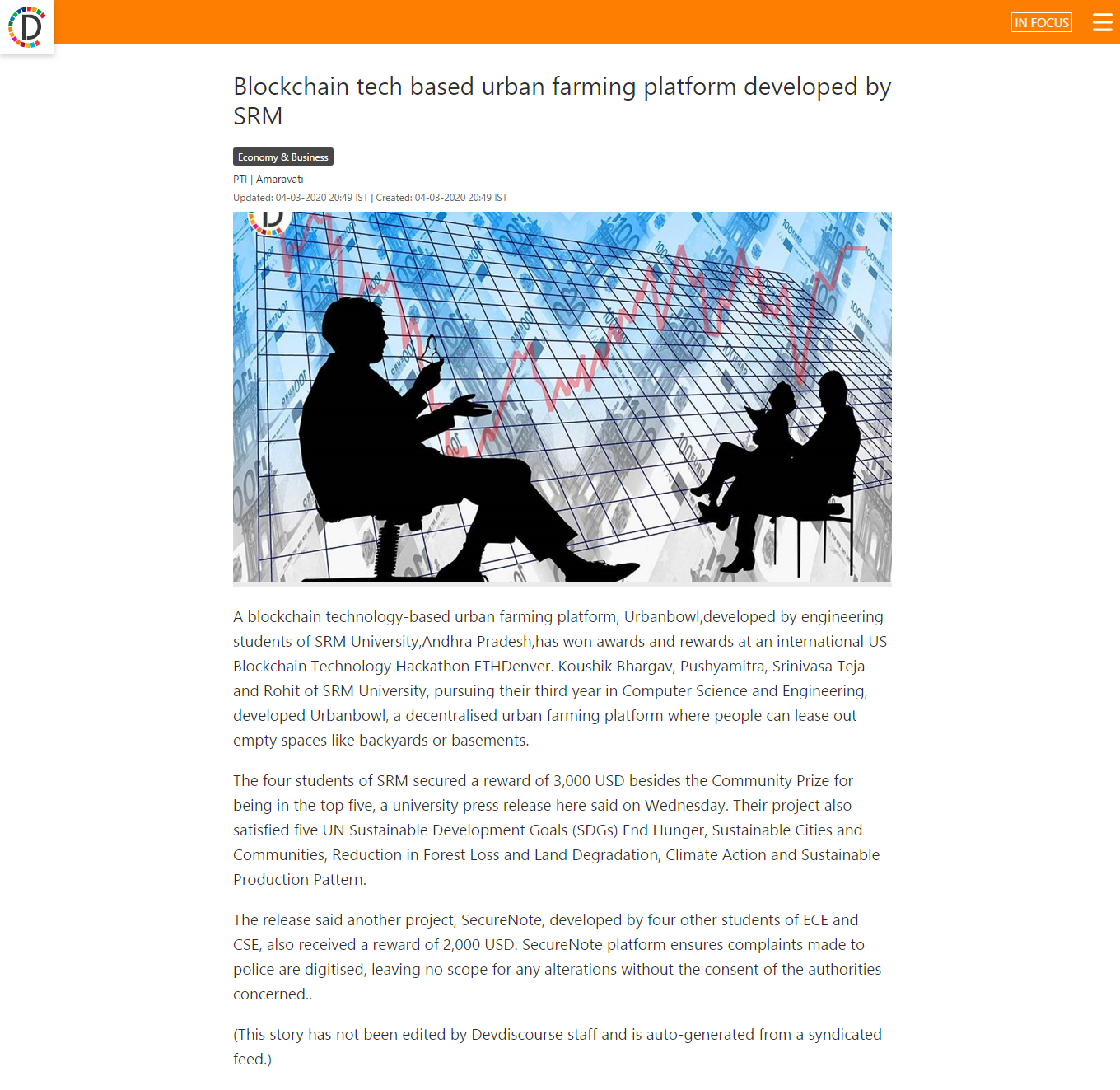
Outlook
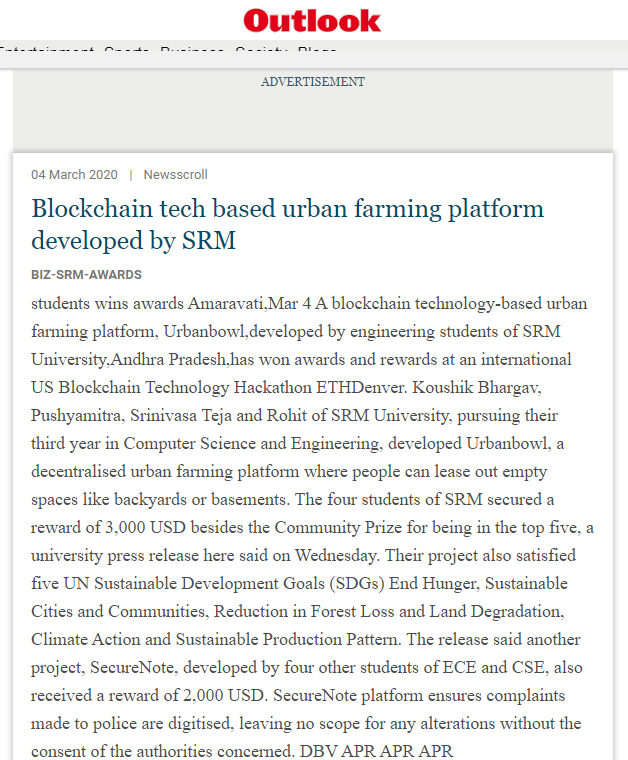
Business Standard
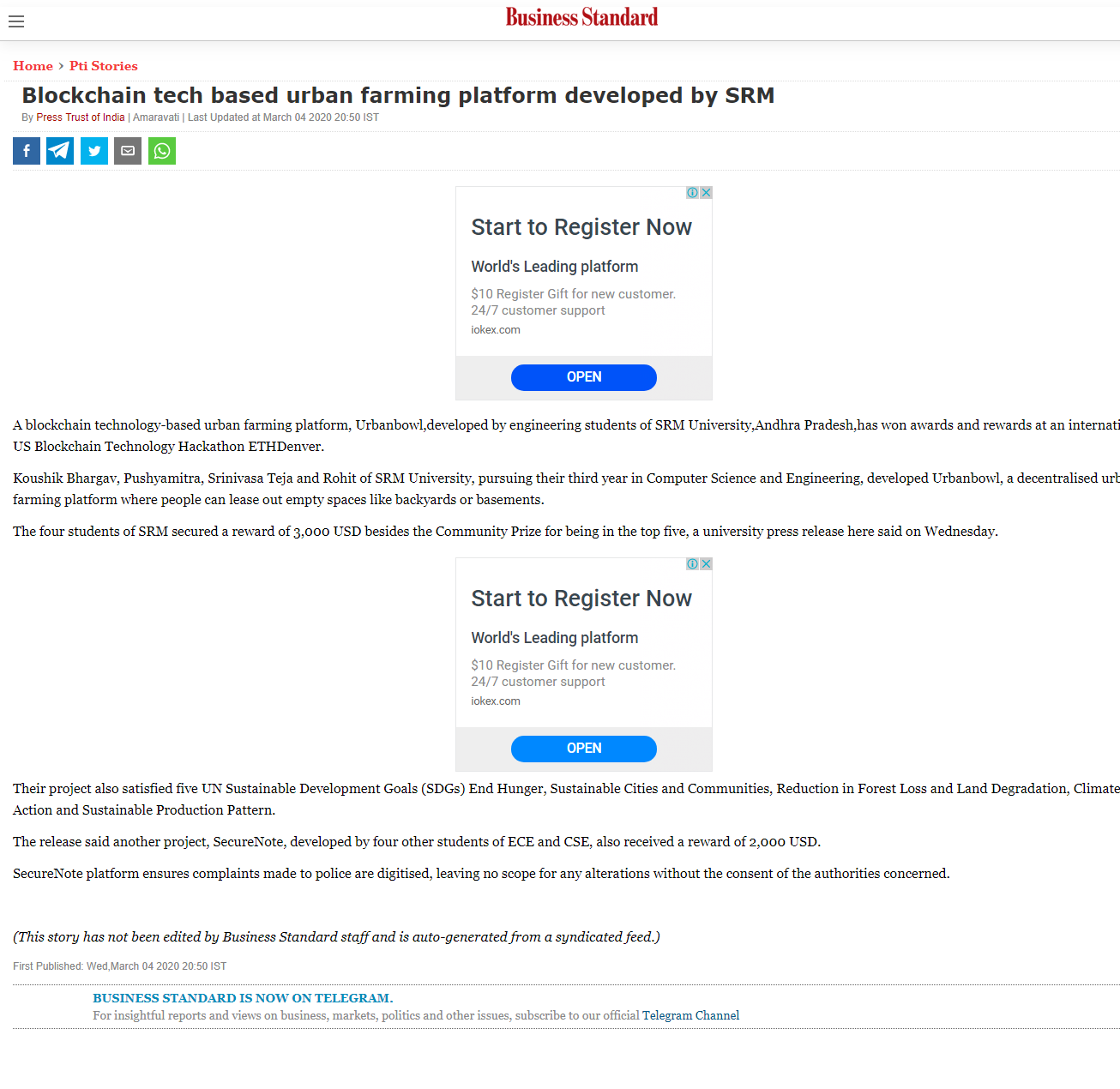
Global Green News
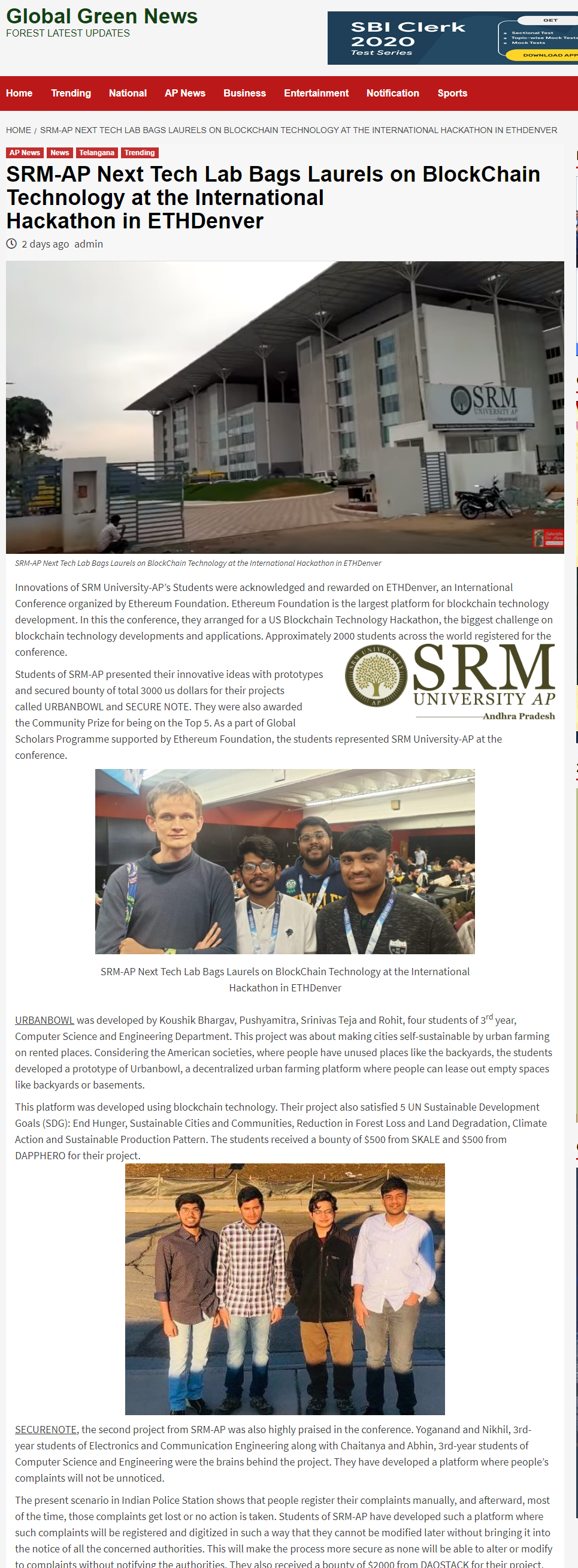
Deccan Chronicle

Saakshi
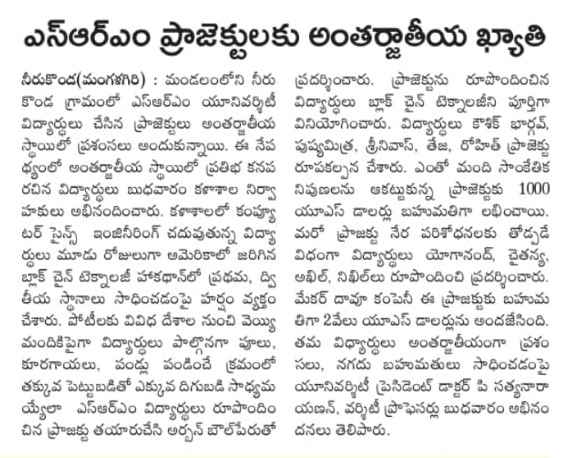
Eenadu
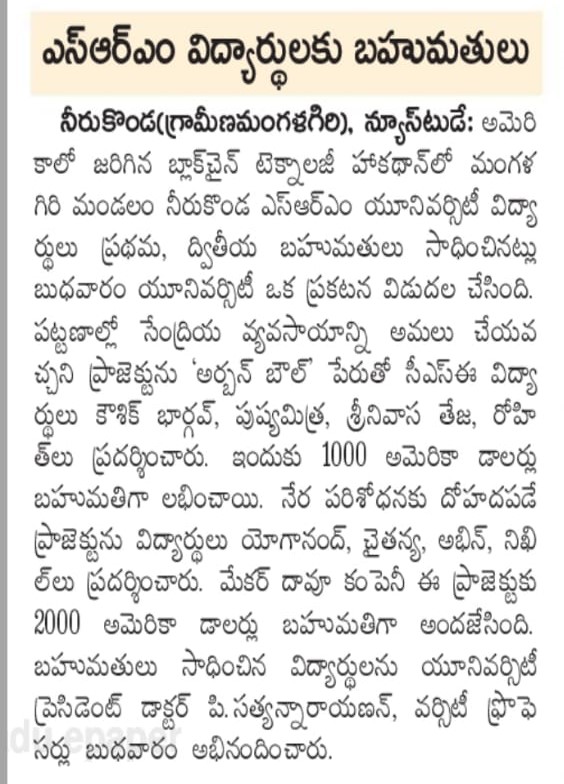
Prajasakti
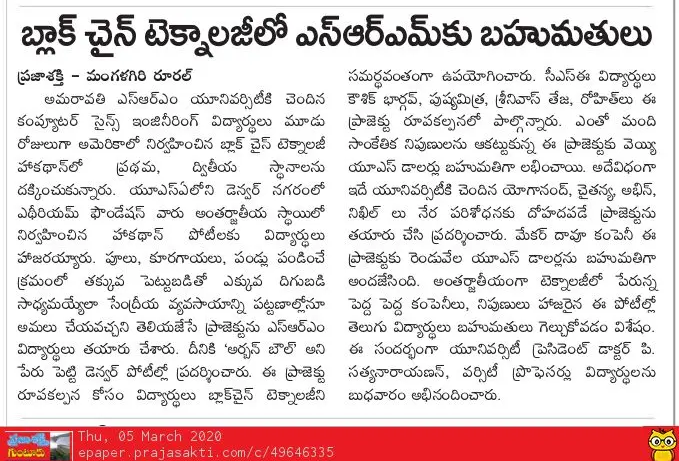
Prabhanews
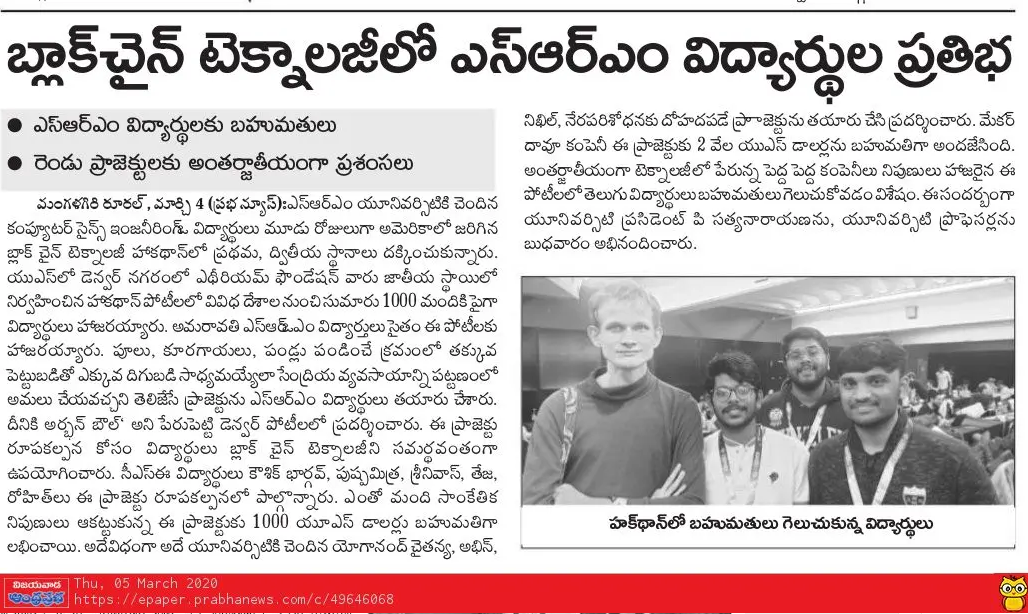
Andhrajyothy
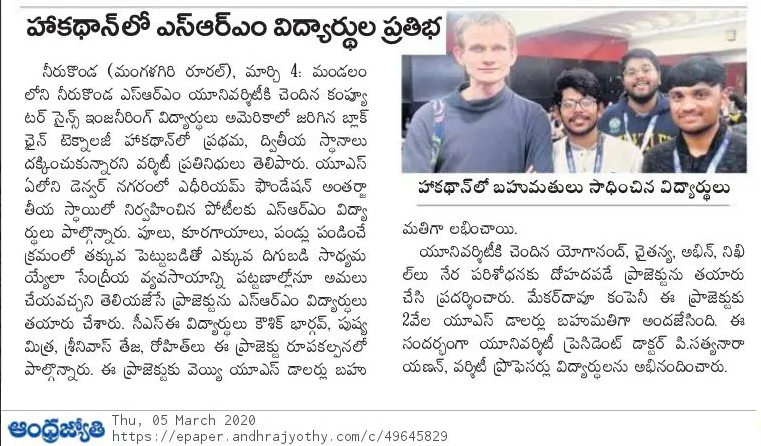
Voodayam Telegu Daily

- Published in Newsroom
Smt. B. Vijayakeerthi celebrate women’s day at SRM AP campus
Encouraging women to break gender-biased roles
Women’s Day is celebrated across nations recognizing their contribution to every sphere. The day also aims at accelerating gender equality by empowering women. SRM University, Andhra Pradesh observes a week-long celebration that reached its orchestral height on Saturday. Upholding the spirit of equality, faculty, staff and students came together to participate in fun activities, games and competitions hosted throughout the week. This included spoon and lemon race, tug of war, bucket and ball, musical chair, singing competition, dancing competition, Mathematics contest- Ms. Hypatia, and essay competition. Everyone in the campus observed 7th March as an Ethnic Day by draping themselves in traditional wear, enunciating the beauty of the occasion.
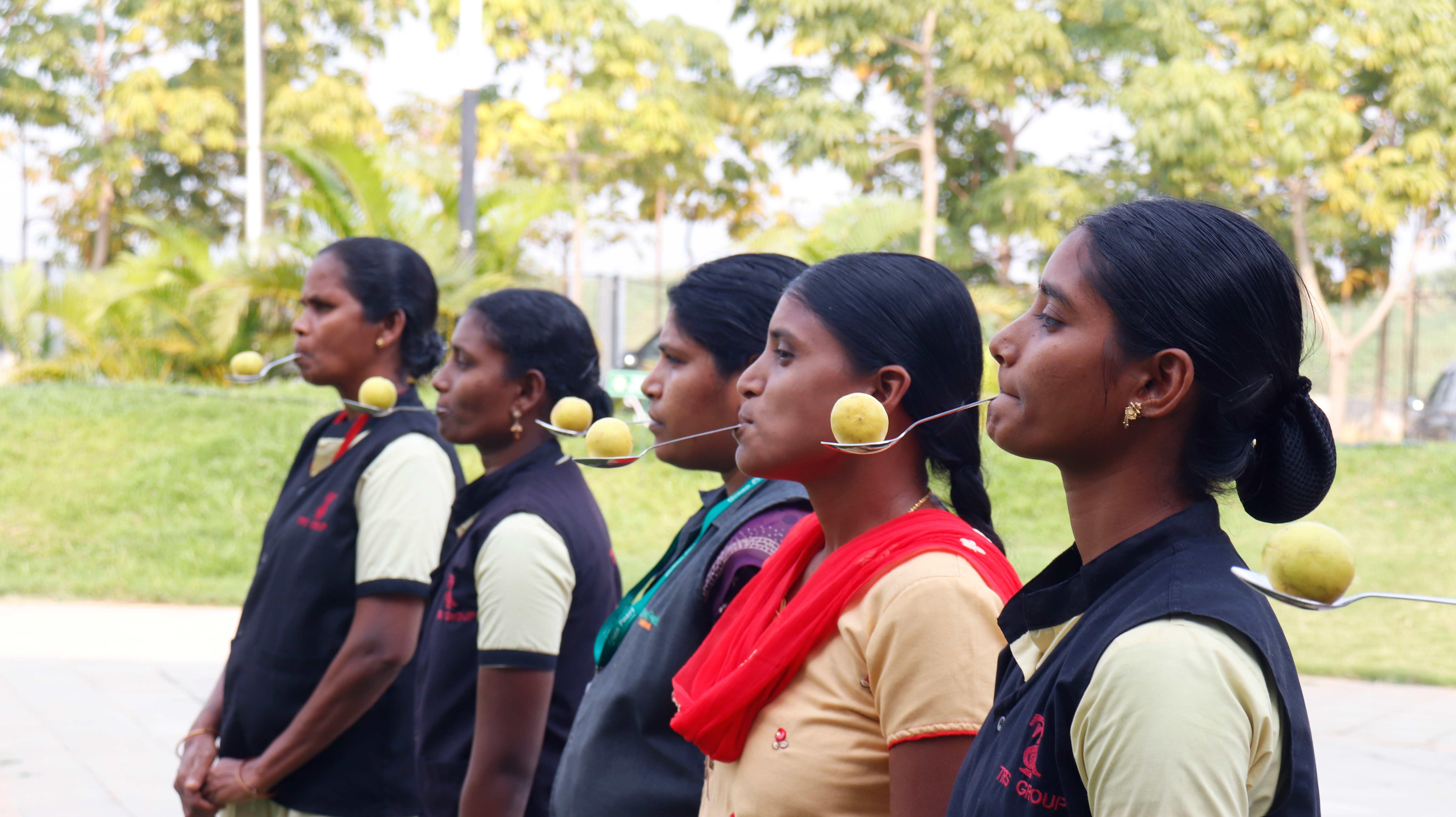 Lemon and spoon race
Lemon and spoon race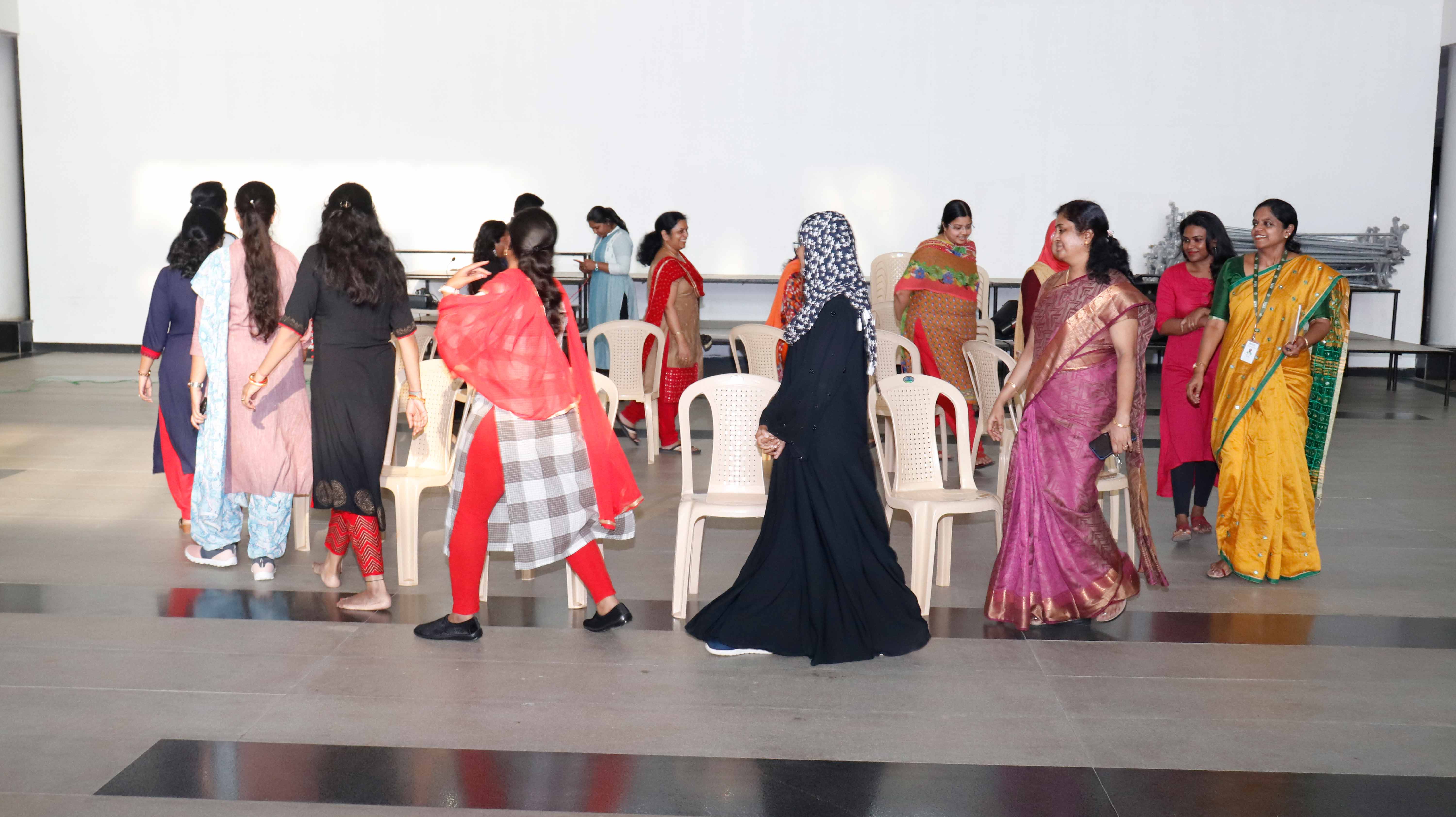 Musical chair
Musical chair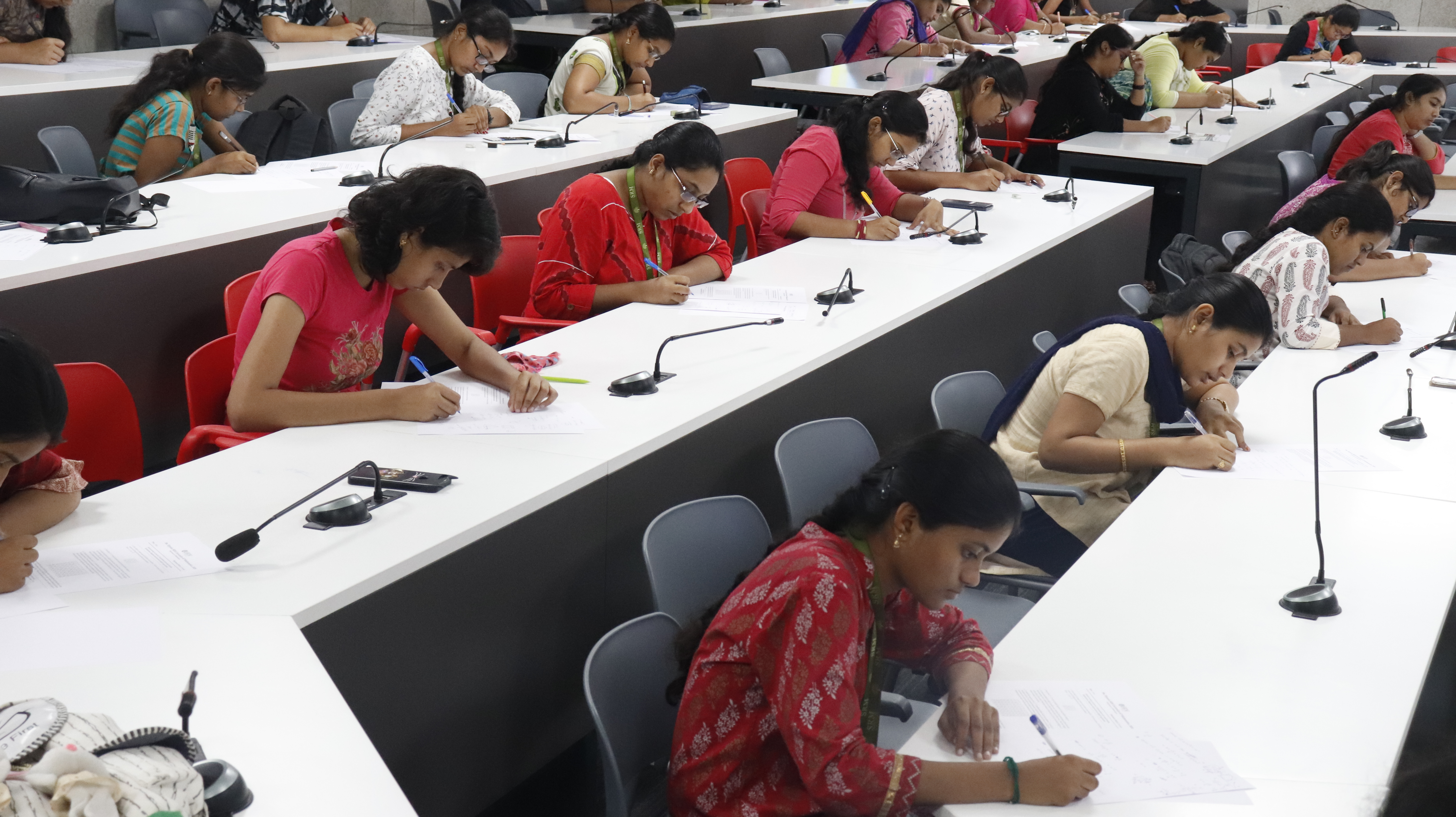 Ms. Hypatia competition
Ms. Hypatia competition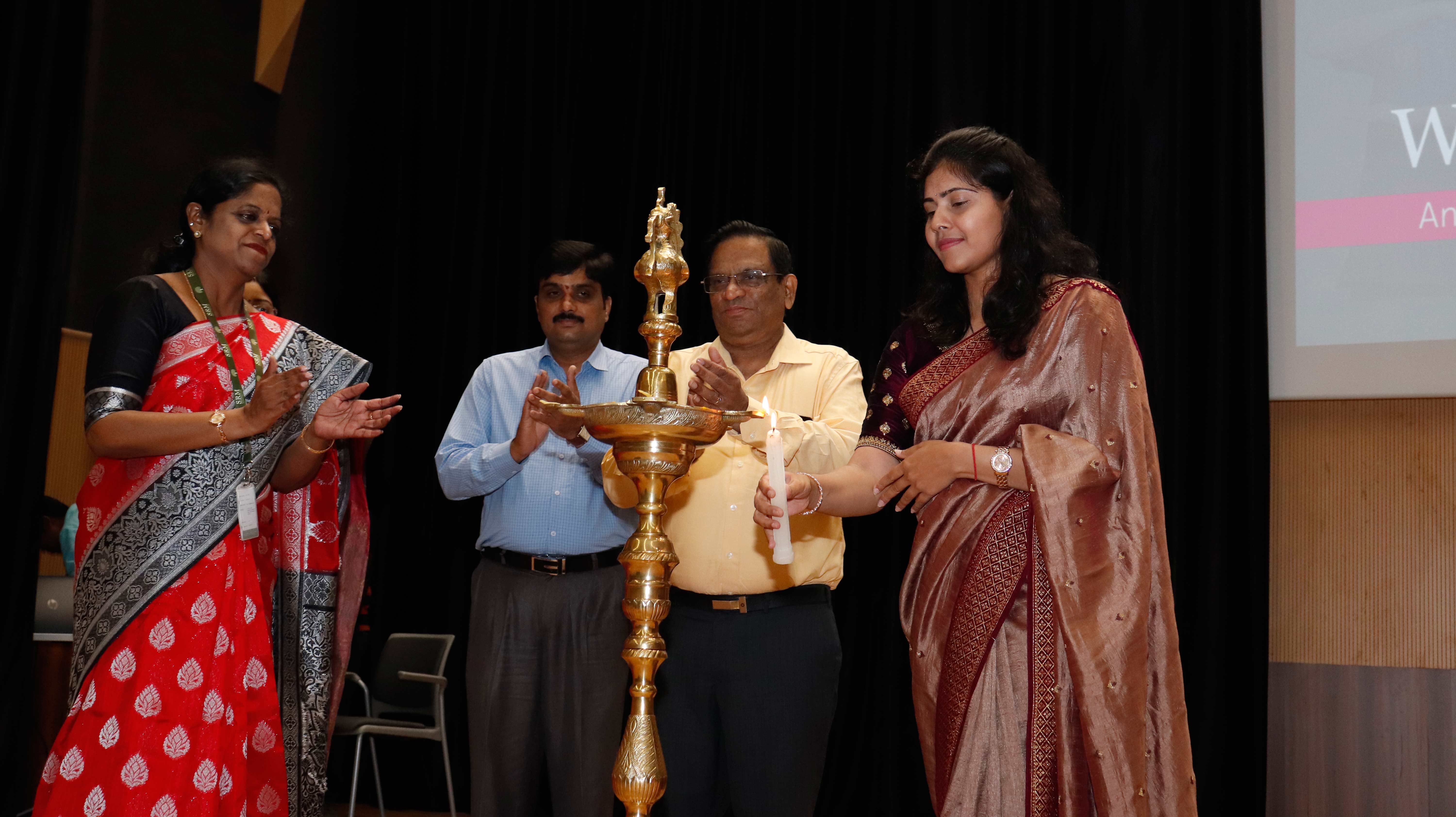 Lamp lighting by the Chief Guest
Lamp lighting by the Chief Guest
With grand exuberance, SRM AP welcomed the Chief Guest, Smt. B. Vijayakeerthi, IRSE, Divisional Engineer, South-Central Railway, Guntur. She initiated the celebration by lighting the ceremonial lamp, along with Prof. D. Narayana Rao, Pro VC, Dr. B. Sivakumar, Deputy Registrar, Ms. Revathi Balakrishnan, Convener, and a student. Breaking gender biased roles, Smt. B. Vijayakeerthi pursued a career in Civil Engineering. A student of IIT Madras, she later aced Indian Railways Service of Engineers examinations and joined Indian Railways. She recalls, “From the day I chose Civil Engineering, I was questioned by society as the norm was that women avoided taking up engineering domains that involved field-work. However, irrespective of my gender, I persuaded my dream and challenged myself to excel against all odds. Initially, although encouragement was rarely found, persistence and hard work ensured that support started pouring in from all ends.”
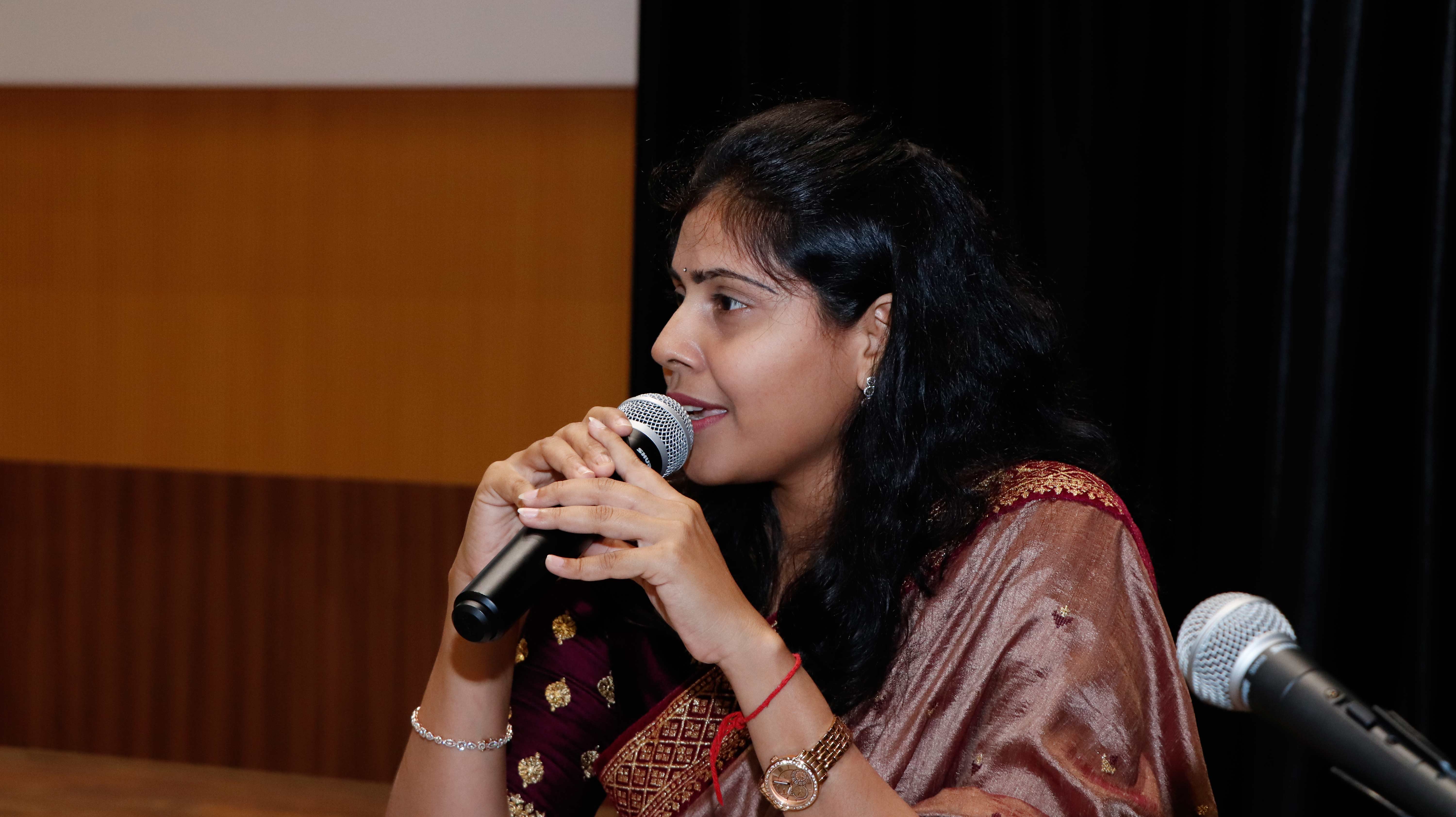 Smt. B. Vijayakeerthi addressing the audience
Smt. B. Vijayakeerthi addressing the audience
Smt. B. Vijayakeerthi set a record by improving the railway track parameters from 96 to 130, and her phenomenal work of eliminating 10 unmanned level crossing gates within a period of 6 months, brought her immense recognition. Persuading young students to follow their dreams, she says “Career choices are solely personal, and it does not depend on gender. One should have the confidence to aim big, and also to take a leap towards achieving the dream.”
The winners of the competitions hosted as a part of women’s day celebration, were honoured by the Chief Guest. The spectacle concluded with the students giving out a social message through cultural program – a skit, song, and dance performance. Their acts demonstrated the societal challenges faced by women and the necessity of bringing about a change to empower them.
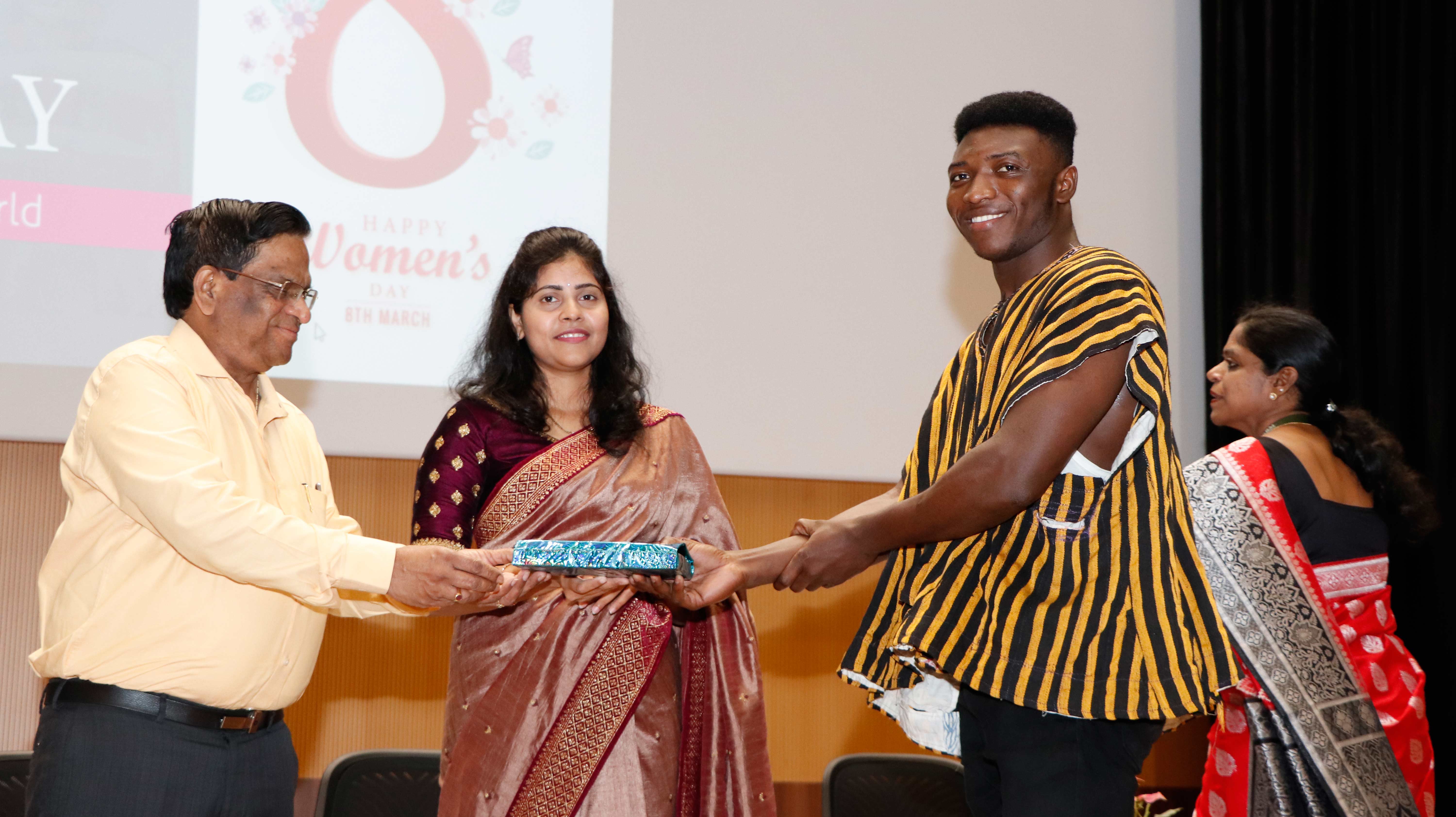 Chief guest presenting the winner’s award
Chief guest presenting the winner’s award
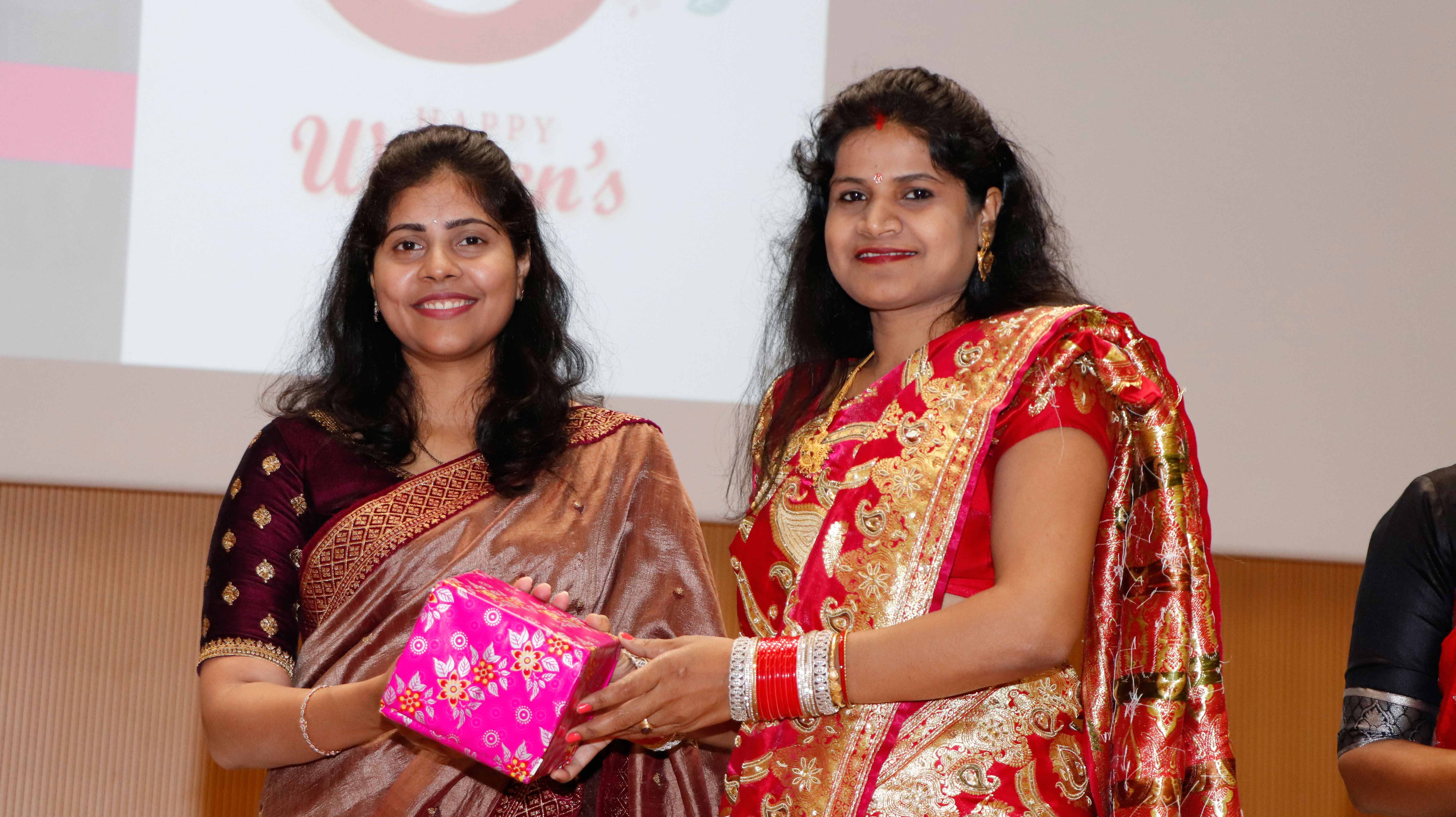 Staff receiving prize for winning ‘Musical Chair’
Staff receiving prize for winning ‘Musical Chair’
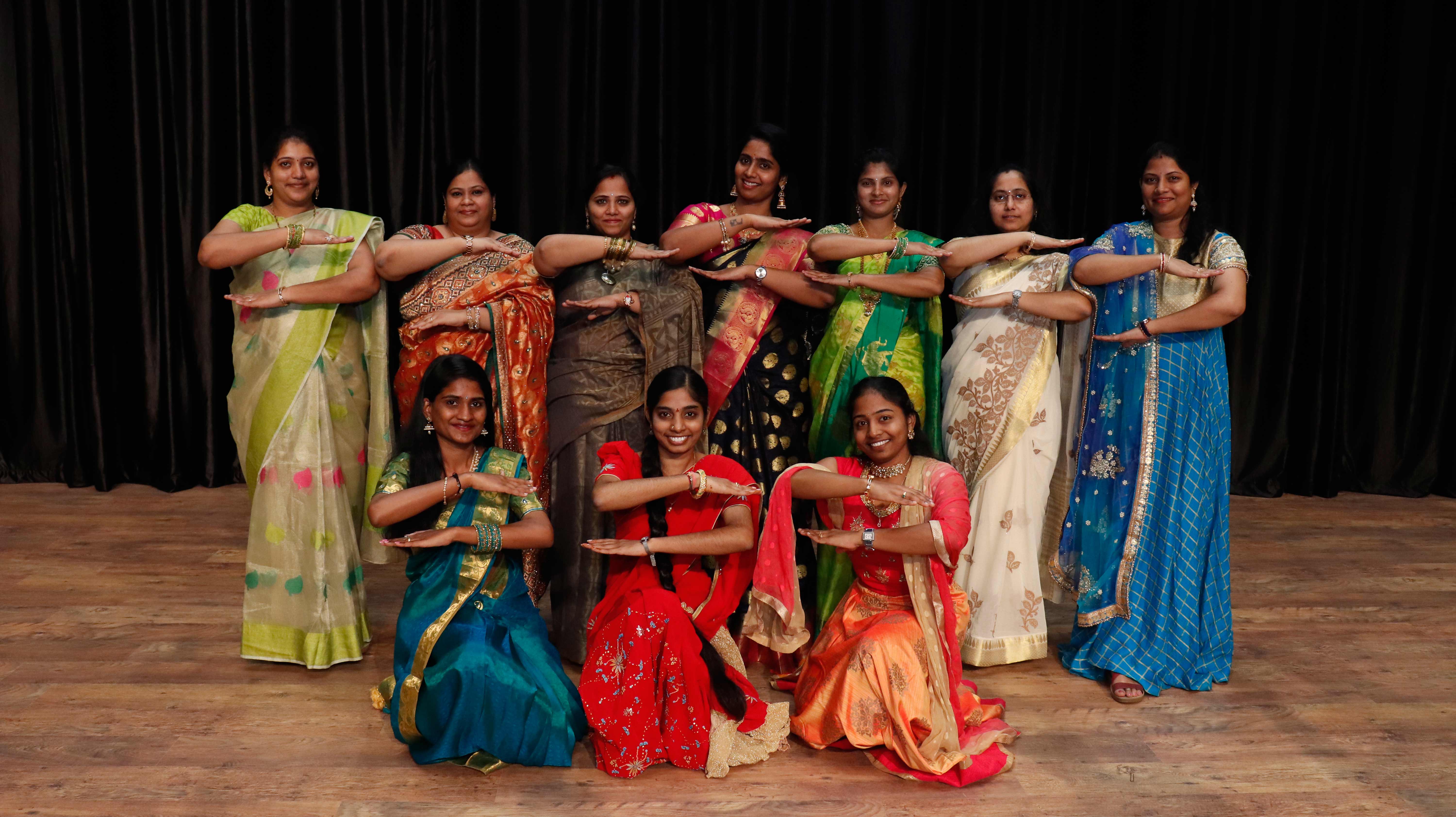 Symbol of equality
Symbol of equality
Picture credit (photography society)
Madala Yasaswi
AP19211010019
BBA
Amrutha Tadisetty
AP18110020128
ECE-B
- Published in Events
Code-lovers Competed for Excellence
The tech-savvy students of SRM University-AP never rest in leisure. Their spare time is also loaded with fun-filled tech-based events. The Coding Club of SRM University-AP organised a first ever coding competition for the code lovers on March 4, 2020. Not merely for the engineers, but the competition was open for all the students. Irrespective of departments, approximately 59 undergraduates took part in this competition.
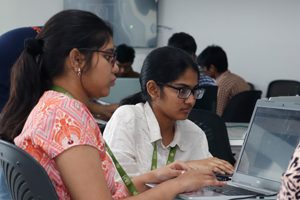 Concentrating
Concentrating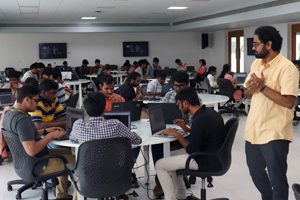 Dr. Bhanukiran Supervising
Dr. Bhanukiran Supervising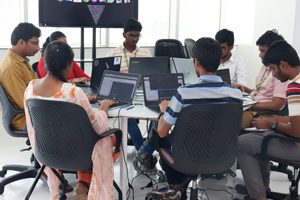 All geared-up
All geared-upThe competition comprised 12 questions, of which some were multiple choice based and some were programming based challenges. Students were at liberty to choose any programming language as per their inclination. “Logic, Mathematics along with algorithmic thinking are the key factors for winning this competition”, said Dr Bhanukiran, Assistant Professor, Computer Science Engineering and organiser of the event. The students were given one and half hour to finish the competition. “Classroom studies are not everything. Students need to have some hands-on experience. Coding is something which cannot be learnt within the limit of books. This competition will give the students the exposure and experience of coding that they really need. It will also prepare the students for their future industry endeavours” added Dr Bhanukiran. Great excitement was seen among the participants. Charan Tangirala, the winner of the competition said, “It was a deeply enriching experience for us. Coding is something I’m very passionate about, and to be able to solve challenges within a specific period of time makes it more exciting. I am looking forward to more healthy competitions like this in the future.”
To know more about the coding club of SRM University-AP, please follow the link below-https://sites.google.com/srmap.edu.in/coding
- Published in Departmental Events
Marathon Hackathon win!
Next Tech Lab continue with the winning streak
SRM University AP, Andhra Pradesh equips students to combat adversities and continue to achieve accolades by nurturing their talent and offering them an impetus for growth. Abbas, a third-year CSE student, wins yet another Hackathon at Berkeley. While on his semester abroad program at the University of California, Berkeley, he participated in Hacktech which is Caltech’s premier intercollegiate hackathon. Along with three other team members from Georgia Tech, Virginia Tech, and USC, Abbas competed against 450 hackers who identify and build innovative, technological solutions to solve problems in a variety of disciplines. The team was a finalist in the “Best Overall Hack” and won “Best Hack That Gives People a Voice” by Facebook.
Focusing on “Giving People a Voice”, sponsored by Facebook, Abbas, and team coordinated through Git and voice messaging platforms like Discord and Slack as the Hackathon turned into a virtual competition with the unfortunate outbreak of COVID-19.
SRM AP’s Next Tech Lab team have developed MeetMe, that provides a platform to interact with various people across the globe, irrespective of their background. “MeetMe is a platform that is designed to take the user out of their comfort zone and have them meet people quite different from themselves.”, explains Abbas.
When asked about the intention behind developing such an application, Abbas says, “When pandemics like Coronavirus hit, despite millions being fatally impacted, most people face challenges like Xenophobia causing added fear and damage. We felt that we should do our part to help make the world a better place using technology. We came across UNICEF’s 5 things to do to fight xenophobia. It primarily suggests that connecting people across cultural backgrounds can eliminate prejudices against a certain group, community, or race. Hence, we developed MeetMe.”
The team believes, “MeetMe will encourage people to interact with groups that they are unfamiliar with, which helps them to understand their cultures better, leading to communal harmony and mutual understanding. This could be particularly useful in the wake of catastrophes such as Coronavirus that unfortunately cause incorrect opinions pertaining to certain groups. By providing a platform for these in-person gatherings, we are trying to ensure that the attendees get the chance to interact with people from marginalized communities and reduce undesired emotions that they may harbor consciously or unconsciously towards them.”
- Published in News
Smart Coating Materials to Reduce Thermal Heat Wave
Cost-effective solution to Global Warming
Renowned publishing house Elsevier is publishing Energy Saving Coating Materials-Design, Process, Implementation and Recent Developments (1st Edition), a book edited by Dr Goutam Kumar Dalapati, Associate Professor, Department of Physics, SRM University- AP and Dr Mohit Sharma, Scientist, A*STAR (Agency for Science, Technology and Research), Singapore. The book is about their collaborative research on Thermal Management with the application of coating materials.
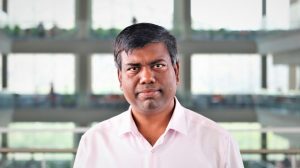
Dr Dalapati, Editor of the book
Countries in tropical and temperate belts such as India, Australia, Middle Eastern and African countries receive most of the sunlight. The heat generation is naturally high in these countries. Studies show that the usage of air-conditioner is also very high in these countries to maintain the desired comfort in both home and office spaces. “Air-conditioners need a huge amount of electricity to be operational. Statistics says, globally, out of hundred units of electricity, almost 35-40 units are used for air-conditioning for either heating or cooling purposes. It also has other drawbacks as it generates air-pollutants which aid in global warming. Our Study in the lab of A*STAR shows that even a one-degree change in the air-conditioner’s temperature settings can save a significant amount of electricity. In our study, we have focused on ways of passive cooling, i.e. how the indoor comfort can be maintained without electricity.” Dr Dalapati said.
Dr Dalapati’s book is about developing new materials and process which can effectively reduce temperature inside the buildings. With a vision of having zero-emission buildings in the future, this book focuses on materials, interactions of these materials with sunlight, and then how these materials can be used productively to reduce the temperature in a building, minimising the thermal budget. His team has proposed different type of materials along with different type of techniques. One of those innovative techniques is, Solar Smart Film, which he has a patent for. When applied on the glass, Solar Smart Film is an effective coating material to block the infra-red radiation, which causes the heat, and it allows the visible light only. When applied on concrete, the coating (cool paint) reduces the heat there too. This smart film can reduce the increment of temperature from 2 to 10 degrees centigrade. The usual product available in the market is silver based, hence highly priced. Dr Dalapati’s team has replaced silver-based products with alternative materials like copper or copper-like materials which are cheap in cost, environmentally stable, non-toxic and can be found easily. The process to develop low cost solar films is also explained in his book.
When asked how the idea of publishing a book came to his mind, Dr Dalapati replied, “At first, we published a 100-page article on a similar topic in Progress in Materials Science, a reputed International Review Journal with an Impact Factor of 23.72. Later we thought of publishing a book because whereas an article’s reach is limited within the researchers only, through a book many more people will come to know about our research and its impact on the well-being of the society. It will help in creating a general awareness among common people as well as young minds like high school and college students will be provided with opportunities for brain-storming.”
Dr Dalapati is currently busy in making his product commercially available. He is also developing apparatus for human applications, which will protect the body from thermal heat waves in summer. A patent application has been filed to the Government of India in this regard. In the Future, he also plans to publish further editions of this book where more complex problems will be discussed.

Cover Page of the Book
DETAILS OF THE BOOK:
Book Title: Energy Saving Coating Materials-Design, Process,
Implementation and Recent Developments (1st Edition)
Editors: Goutam Kumar Dalapati and Mohit Sharma
Paperback ISBN: 9780128221037
Publishing House: Elsevier
Published Date: 1st June 2020
Page Count: 368
Language: English
Copyright: © Elsevier 2020
- Published in News
Dr. Monika Setia, Fulbright India, conducts a session with the researchers
Giving leads to aspirational scholars
Dr. Monika Setia, Regional Officer, Fulbright India, United States-India Educational Foundation, visited SRM University, Andhra Pradesh for a talk on the fellowships offered by the foundation. This binational body is renowned for attracting the best minds and providing them the adequate infrastructure to bring out exemplary research results. The fellowships are equally funded by the foundation and the government of India under the flagship of Fulbright-Nehru fellowships for Indian citizens. Every year among hundreds of applicants, few scholars with exceptional acumen are sent to the United States to pursue research in collaboration with the US-based universities and institutes.

Dr. Monika speaks of the 4 primary activities of Fulbright, which is to administer, promote dialogue between participants, offer advice to aspirants, and establish links between the US and India. She emphasizes, “Looking beyond academic excellence, Fulbright fosters cultural exchange between the two nations. The culturally adaptable interdisciplinary researchers driven to contribute to the society, community, and nationality are curated by the selection panelists of Fulbright”.

The attendees of the session were given a heads up regarding several fellowship programs dedicated to master’s students, doctoral students, and post-doctoral scholars. The process of application, eligibility criteria, project timelines were thoroughly explained to the faculty and Ph.D. scholars of SRM AP, adhering to which will escalate their chance of being selected for the prestigious fellowship. The fellowship will give foreign exposure to the scholars, enable them to work with excellent infrastructure in the US, and use their research inferences to improve the society as a whole, across national boundaries.
- Published in Invited Talks
Students showed their mettle at Sports Meet, brought home trophies!
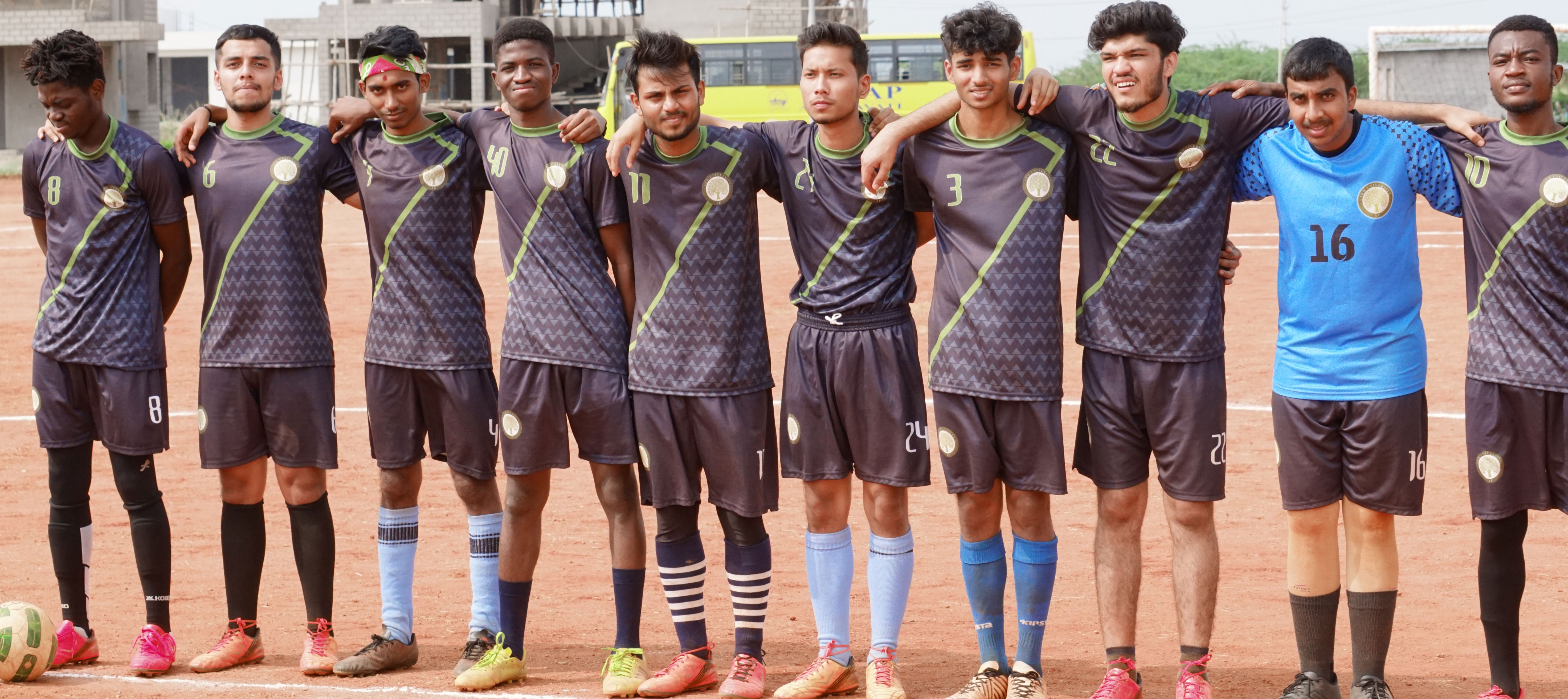
Football Team of SRM University-AP
There is a famous saying “All work and no play makes Jack a dull boy.” Therefore, here at SRM University-AP, students are always encouraged to go beyond the limits of curricular activities. The Students of SRM-AP have proven to be all-rounders by winning several cups in various segments of different Inter-College Sports Meet. VIT-AP and MVR College of Engineering and Technology have recently organised the Inter College Sports in their respective campuses. Students of SRM-AP merrily participated and successfully bagged winner’s trophy in football and cricket and the runner-up trophy in lawn tennis in Vitopia, Sports Tournament of VIT-AP. They have also secured the winner’s trophy in cricket, and the runner-up trophy in badminton in the Inter-college Sports Championship organised by MVR College of Engineering and Technology.
The football team of SRM-AP was invincible. Their incredible performance throughout the tournament took them straight to the finals where they thrashed VIT-AP, another finalist with a straight 3-0, a resounding victory without any doubt. SRM University-AP team’s captain Ishmael, a 3rd-year Mechanical Engineering student, was able to lead the team successfully. He also turned out to be an ideal strategist. Andrew, another 3rd-year Mechanical Engineering student, sent the ball into the net twice during the match, whereas Venky, 1st-year Computer science and engineering student, supported his team by scoring another goal.
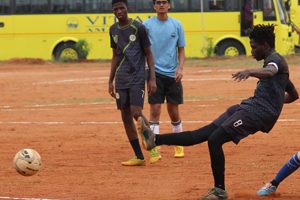
Aiming to Score
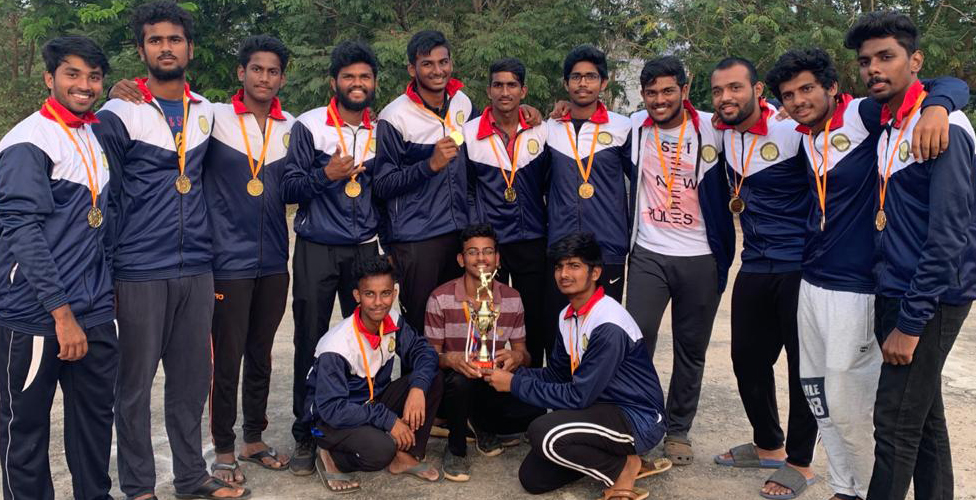
Cricket Team with the Trophy
Our cricket team has proven their talent by winning two consecutive champion’s trophy both in VITOPIA and MVR Sports Meet. Jaswanth, a 3rd-year Electronics and Communication Engineering student and the captain of the cricket team, says, “our team has some up-and-coming players. However, at the end of the day, it is the team effort that leads us to success.”
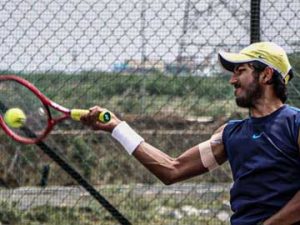
GKV Manikantha hitting the ball
Lawn tennis is another game of hardcore physical strength mixed with ingenious strategies. GKV Manikantha, 1st-year Mechanical Engineering student and a passionate player, won the runner-up trophy at VITOPIA, yet it could not make him happy. He said, “Due to my injury, I could not put up a fight in the finals. I was hurt and therefore had to retire from the game. I am trying to have a speedy recovery and will be back very soon.”
Twelve teams from different colleges participated in the badminton tournament. RK College OF Engineering, Velagapudi Ramakrishna Siddhartha Engineering College, DVR & Dr HS MIC College of Technology, GDMM College of Engineering & Technology were a few among them. Though our team could not secure the first prize, Rathan, a 2nd year CSE student, put up a marvellous fight which brought the university the runner-up trophy.
- Published in News


